-
 856 Hits
856 Hits
-
 80.49% Score
80.49% Score
-
 12 Votes
12 Votes
|
|
Mountain/Rock |
|---|---|
|
|
39.71938°N / 21.62948°E |
|
|
Thessaly |
|
|
Trad Climbing |
|
|
Spring, Fall |
|
|
2297 ft / 700 m |
|
|
Overview
Kaukasier
The name Meteora - meaning "hanging in the air" - probably refers to the spiritual, intriguing and misterious atmosphere surrounding the place and more concretely to the vertiginousness of its rocks, which are about 170 in number, in the form of spiers, towers, pinnacles, peaks and massive summits. Each of these peaks is reachable exclusively by climbing, having a real summit without any easy access. The rocks overlook the inhabited centers of Kastràki and Kalabàka located in the Thessaly region of Greece and feature about 850 multi-pitch and single pitch routes. Due to their singularity and a bit of mistery surrounding the place, in addition to the presence of various monasteries, the towers of Meteora are quite famous all over the world.
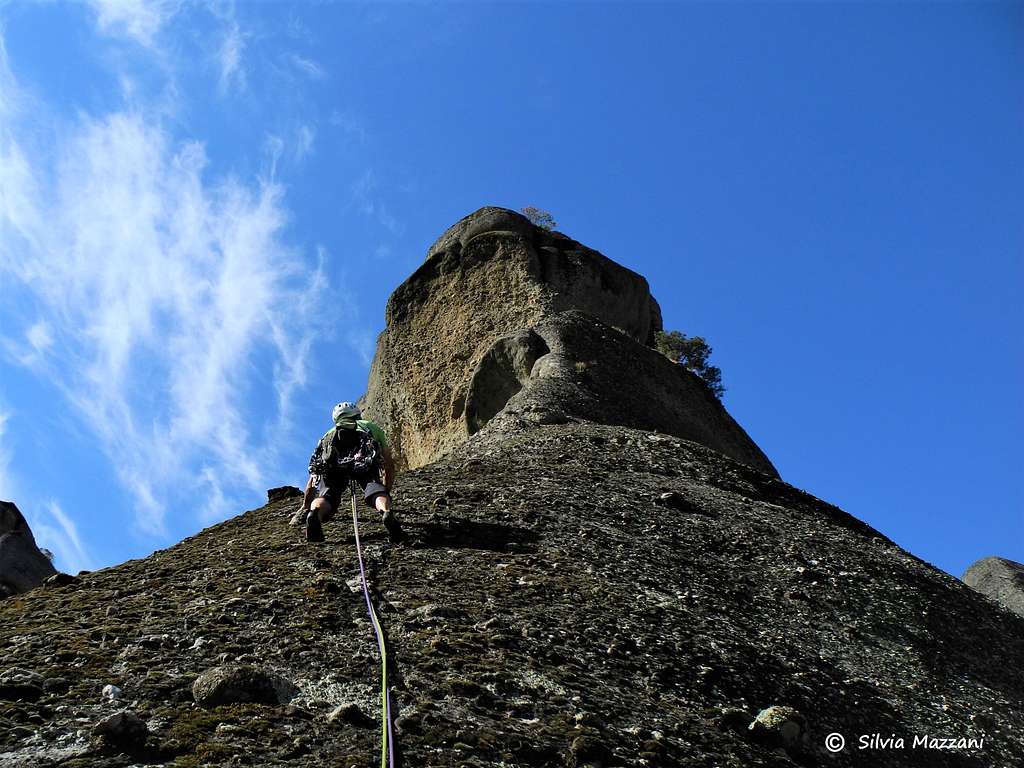
Kaukasier is a tower located on the right side of the road connecting the village of Kastraki with the highest monasteries. Precisely it is located on the left of Kumarieskopf, as well of the massive structure of the Holy Ghost (Aghion Pnéuma in Greek). The Kaukasier Tower is located at a close distance from the Roussanou Monastery. The only existing cimbing route on the tower is called Roussanou Kante, ie Roussanou Ridge, taking place right in front of the aforementioned monastery.
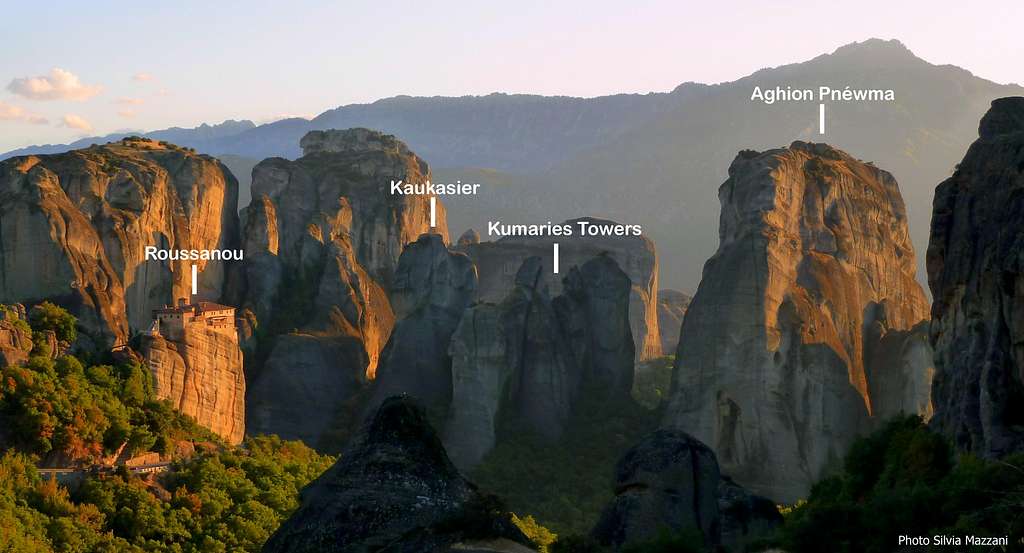
The Monastery of Roussanou was first established in the 14th century. The name “Roussanou” probably derives from the first hermit who settled on the rock in that period. The monastery is one single building occupying the entire surface area of the spire, indeed it even creates the impression that the building was carved out from the cliff as the extension of the rock itself! The monastery was badly damaged during the World War II. It became a convent in 1988 and today more than 15 nuns live in the beautiful little Roussanou monastery.
Getting There
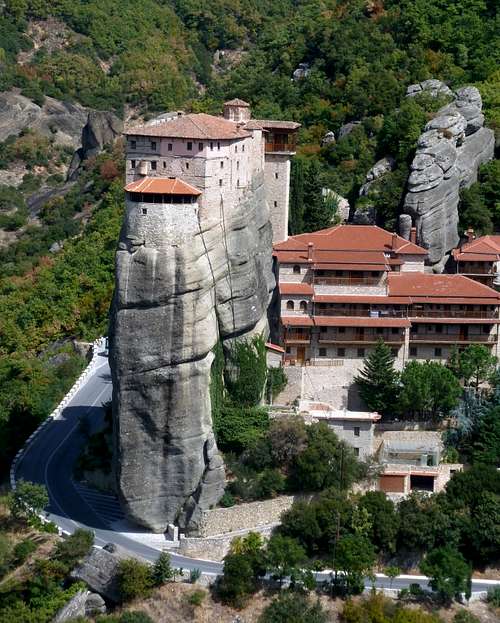
Meteora is situated in the Thessaly region of Greece, Northern half of Greece, approximately 25 km NNW from Trikala, and immediately North of Kalambaka and Kastraki, the two main towns in the area, both located very close to the rocks. The closest main town is Larissa. The distance to Kalambaka is about 360 km from Athens and 237 km. from Thessaloníki.
By plane - Meteora can be approached from Athens Eleftherios Venizelos airport or from Thessaloniki airport. From these airports you can:
- take a domestic flight to Larissa (about 85 km from Kalambaka) - rent a car, useful once you are in Kastraki, but not essential, then 4 hour drive to Kalambaka on a new highway. - use public transports (bus or train). Getting to Meteora without a car is easy thanks to the train from Athens that stops in Kalambaka.
By ferry from Italy – If you wish to travel with your own car, there are different shipping companies and many ferries departures to Igoumenitza from the harbours of Ancona, Bari and Brindisi across the Adriatic Sea. Then a mountain road to the small town of Kalambaka at the foot of the wonderful Meteora.
Roussanoukante
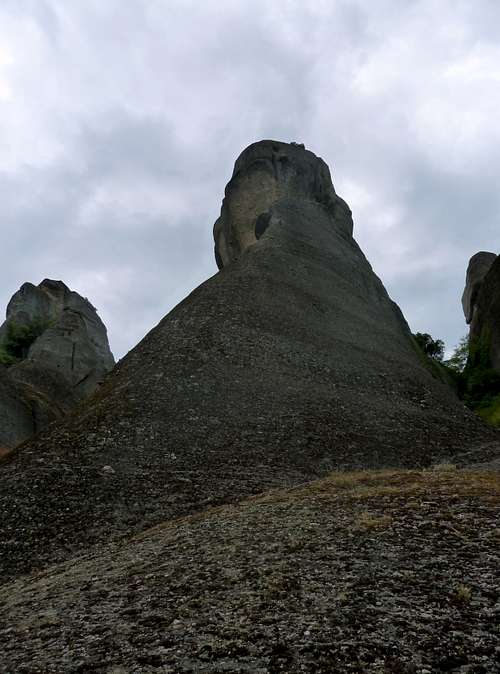
Roussanoukante (UIAA scale)
A route of 5 lengths with an engaging fifth pitch on a hard crack.
Approach
When driving from the village of Kastraki towards North-East to reach the summit monasteries you soon see the rounded peak of the Doupianifels on the left near the road and just in front on the right the Holy Ghost (recognizable for the niches with flags in the middle of its wide wall) and Holy Ghost Guardian (a spire resting on the wall of Holy Ghost). After a bend towards right, the road passes a pull-out on the left. Continue driving and reach a little pull-out just in front of the obvious mighty structure of Aghion Pnéwma. Park the car and take a path descending to the bottom of the valley, then crossing the path coming from the village. Take the right to get the routes 1-2-3 and the left one to get the routes from 8 to 15. After a bend towards right, the road passes a pull-out on the left. Continue driving and reach a little pull-out located higher up in front of the Kumarieskopf and the adjacent Kaukasier. Park the car and take a path descending to the bottom of the long valley which runs along the road on the right. Briefly rising in the small wood reach the base of the tower.
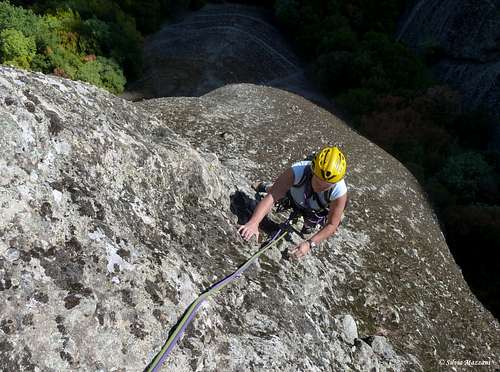
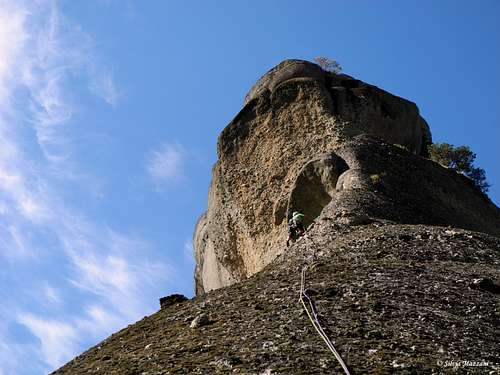
Report
L1 - L2 - Climb the wide and sloping basal slab, III, IV-, 70 m. The second belay is on the left.
L3 - Climb a steep small pillar, then a small dihredral and a wall. Finally a delicate slope avoiding the edge of the tower to the right leads to the third stance below some yellow overhangs, IV +, 35 m
L4 - Climb a groove on the right, then a technical and shallow corner reaching a stance below a crack, V+, 15 m.
L5 - Challenging pitch. Up the hard crack with jam technique - to be protected - exit right on a edge, then climb another crack on the left. Up a crumbling wall to the summit.
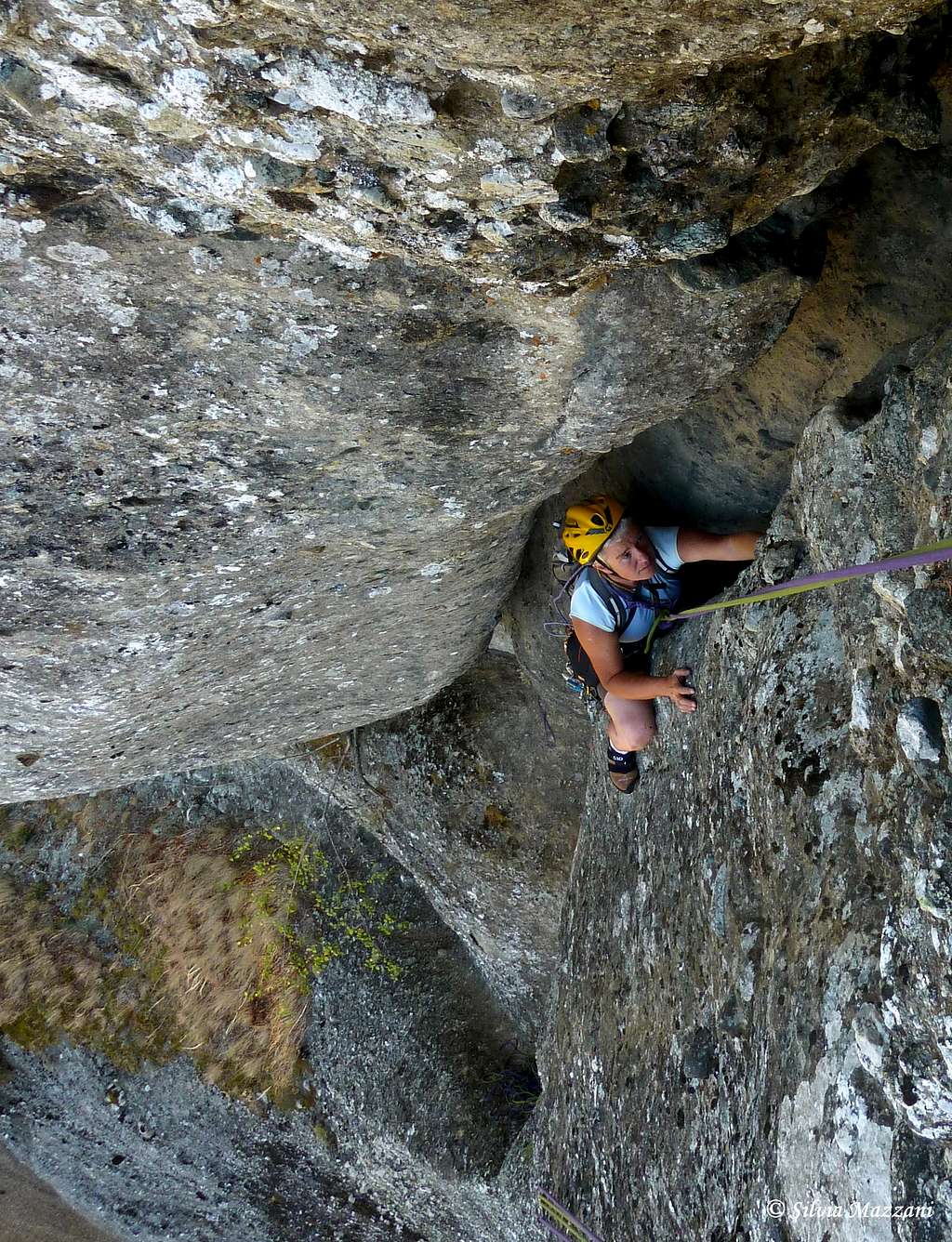
Descent: cross the broad summit in the opposite direction to reach an anchor. A 10 meter abseil to another anchor. 2 more abseils lead to a vegetated gully, going down to the starting point.
Red Tape
No fees and no permits required. Anyhow, if you are visiting this area, remember not to climb on rock formations with inhabited monasteries. In the Seventies Dietrich Hasse and his team decided, in agreement with local authorities, not to climb any route on these latter rock formations. This rule applies even today. Please preserve all other historical remains. Another important suggestion is not to add fixed protections on the classic routes to the pre-existing ones. If you plan to visit the monasteries, keep in mind to be appropriately dressed: men cannot wear shorts, while women must wear long skirts and not trousers, arms must be covered. Since the year 1988 Meteora was declared a Meteora Unesco World Heritage Site .
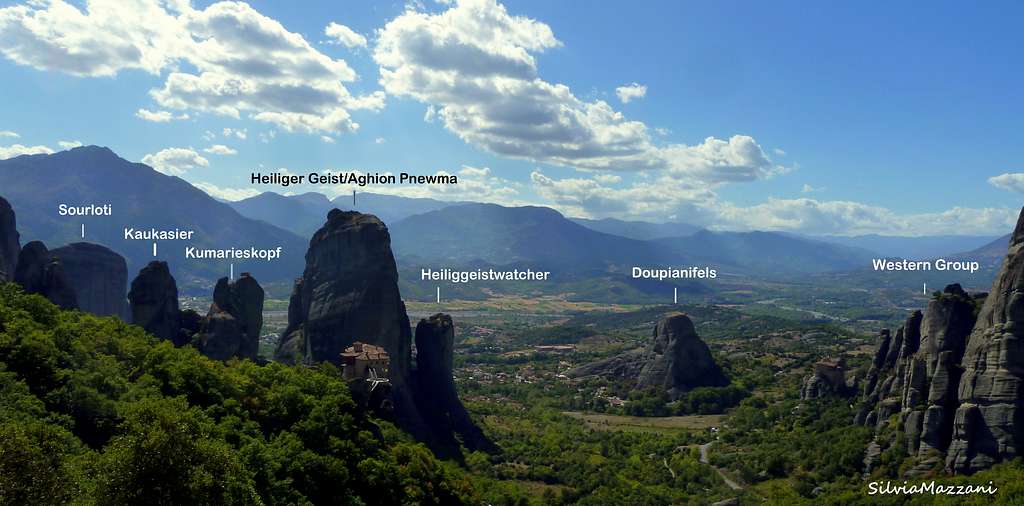
Rock climbing and geology

Climbing in Meteora is different! The nature of the rock is very peculiar, the pegs often spaced, especially on the classic routes of the pioneers, every routes ends on a true summit that involves rappels. The magnificent surroundings and the ambience make the climbing at Meteora a singular experience. However, there are also more recent routes with a sporty character, high difficulty and more generous equipment. All the towers and spires in Meteora, even the smallest, have a summit book and as a rule usually have two names (and sometimes plus the English version): the local name in Greek and the German name. The genesis of the German name is explained by the broad activity of East German pioneers. The rock is a gray-brown conglomerate. It is believed that the needles began to form in the Tertiary - about 60 million years ago - starting from the materials deposited at the border of the Thessaly plain when the prehistoric sea waters, which previously covered the plain, withdrew. Slowly the conglomerates needle were then sculpted over the millennia, by water, wind and earthquakes. The texture of Meteora rock results from a mix of pebbles, cobbles and larger stones, packed into a rock surface which is a mixture of conglomerate and sandstone. Sometimes the cobbles have come out from the rock to leave shallow holes in their place. The rock is predominantly solid and reliable. What emerges is a peculiar climbing style, mainly slabby and balancy on cobbles, consisting in exploiting small or large pebbles protruding, or otherwise the holes remained where the same pebbles were formerly located. As soon as you get used to it, the climb will provide fun and generally little tiring.
Nature and climate
The vegetation is considered as supra-Mediterranean, with climax cover of Quercus and Ostrya species and Fagus sylvatica beech forest above 700 m. The area includes forested hills and river valley covered by forests of Platanus orientalis and species such as the endemic Centaurea lactifolia (Centaurea kalambakensi).
During the summer Meteora is affected by the climate of the tropics, extending its influence into the Mediterranean area and therefore a great heat can be expected, while during the winter the area is influenced by the Central Europe climate, that often produces changes from fair weather conditions to bad weather conditions. Best seasons are the middle ones: Spring till the end of May and early and middle Fall.
Accomodation
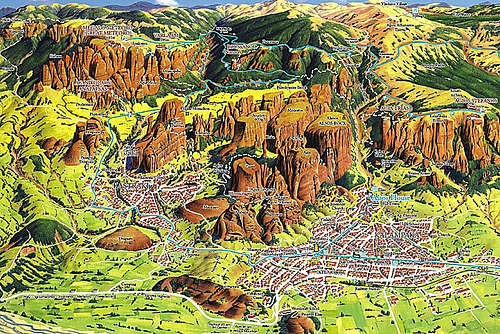
There are a great number of hotels, B&Bs and rooms to rent in the village of Kastraki, the village built in the shadow of the Meteora towers. The nearby town of Kalabaka also features many accomodation choices. There are also three organized campsites, amongst which the nearest one to the crags is the Camping Vrachos in Kastraki. There is also a smaller campsite near the tower of Doupiani. There are plenty of eating out options, particularly tasty traditional Greek food and pizzerias, both in Kastraki and Kalambaka.
When to Climb
In theory it's possible to climb all year round (snowfalls are rare), but summer and winter are less advisable because temperatures may be unpleasant, unless you are very lucky. The best months are March, April, May, September and October. Spring is maybe the best season to climb in Meteora, because the rainy days are rare. Easter time is a very popular time in Meteora and it is probably a bit crowded. Autumn is another good choice until the end of October, when the days should still be moderately warm and dry. Later on, the weather gets more changeable, wet and colder. It is very hot in Summer, but you can still climb in the early morning and late afternoons, or on the walls with a shady location.

Meteo
Guidebooks and maps

“Meteora – Climbing and hiking” by Dietrich Hasse and Heinz Lothar Stutte - I edition 1986, in English and German. It contains around 230 routes. Also, it provides general information about mountaineering, hiking in Meteora, maps, directions.
The second guidebook is:

“Meteora Climbing Part II” by the same Heinz Lothar Stutte and Dietrich Hasse – II edition 2000 – German, Greek and English - Note: the II edition is not a complete guidebook, but an update to the I edition
The Meteora guidebooks can be purchased in Kastraki, Taverna Paradisos or Camping Vrachos. There is also a useful map by the same authors that can be purchased in local shops in Kastraki.

A new guidebook was recently published (2022) by the local climber Vangelis Bastios
Meteora – Sport Climbing Guide by Vangelis Bastios, Edition 2022 - The guidebook includes routes from Meteora, Theopetra, Sarakina and Agia Paraskevi.
Says Vangelis: “Because sport climbing has become increasingly popular in recent years, it helped me decide to create a guidebook for just the sport routes in Meteora and Theopetra (a cliff only 10 km outside Meteora, with good quality limestone).
External Links
Climbing web-sites:
- Climbgreece
- Climb-Europe Greece/Meteora
- Meteora-rock-climbing
The site of Jörg Brutscher, one of the German climbers, who first climbed many hard cracks in Meteora. Unfortunatelly his site is only in german.
Also by Jörg Brutscher, check : www.sandsteinklettern.de. In german only, but with a lot of information. Click on Wegedatenbank, then Griechenland. There are a lot of routes and very good drawings/maps of the various rock groups. Some very interesting climbing photos from Meteora, Elb and other places.
The site www.routes.gr is the best database of mountain climbing routes in Greece. Unfortunatelly has only a few, mainly new, routes from Meteora in this link: www.routes.gr/?Lang=en&Page=Climbing/Trad/Areas/Meteora
Other info here:
The site of Kalambaka town: www.kalampaka.com
The site of the Hellenic Mountain Guide Association.

